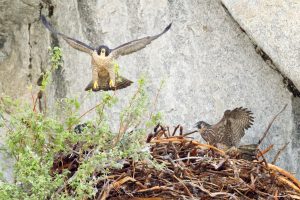Yosemite, CA — Yosemite National Park is witnessing a significant increase in peregrine falcons, with new nests and baby falcons discovered this spring, thanks to a protection program that began more than a decade ago, according to the National Park Service.
Since its inception in 2009 by biologist Jeff Maurer, the Peregrine Falcon Protection Program has doubled the number of breeding pairs. Yosemite researchers have observed 51 new nesting sites since the program’s launch 15 years ago. This year alone, they documented 17 breeding pairs, 25 baby peregrines, and 15 nests. A big contributor to the program’s success is the Yosemite Conservancy, whose donors have contributed $452,000 to the Peregrine Falcon Protection Program.
“It’s a remarkable comeback with new discoveries resulting from a collaborative strategy involving climbers, the National Park Service, and the Yosemite Conservancy,” said Alexandria Walker, Biological Science Technician for the National Park Service in Yosemite. “Peregrines hunt, soar, and nest on and around the park’s granite cliffs, domes, and spires because of a dedicated effort to protect them.”
The Yosemite climbing community plays a crucial role in ensuring the park’s proactive, adaptive approach to protecting peregrines.
“Young falcons depend on their parents for food and protection. If climbers accidentally scare adult falcons from the walls, the nestlings might starve or be eaten,” said Sean Smith, Biological Science Technician for the National Park Service in Yosemite.
In the early years of recovery efforts, Yosemite climbers worked with wildlife experts to replace DDT-thinned eggs with healthy chicks in cliffside falcon nests. Today, climbers learn about temporary off-limits routes and the importance of respecting the closures through signs posted near climbing routes, updates on the Yosemite National Park website, “climber coffee” gatherings, and conversations with climbing rangers and one another.
“By avoiding off-limits areas and educating fellow adventurers, climbers help ensure falcon fledglings have the best chance of survival,” said Jesse McGahey, a Park Ranger in Yosemite.
The peregrine falcon, with its white chest, sharp beak, and yellow eyes, glides on a 40-inch wingspan, transforming into an avian arrow and skydiving in a “stoop” that can surpass 200 miles per hour. Young peregrines, called juveniles, are fluffier and have streaked coloring and a brown face mask. They prey on other birds and bats and often catch their meals mid-air.
“Yosemite’s successful strategy stands out for its focus on balancing falcon management and visitor recreation. While Yosemite’s walls and domes offer ideal habitat for the raptor, that rocky habitat also makes the park a coveted climbing destination,” said Frank Dean, President of Yosemite Conservancy.
In 1978, climbers discovered nesting peregrines in Yosemite after a 36-year absence. Peregrines were declared a federally endangered species in 1970 and added to the California endangered species list the following year. Thanks to a nationwide ban on DDT in 1972 and concerted rehabilitation efforts, peregrines have made a comeback, with the population estimated to include 72,000 individuals in the US and Canada. The falcons were removed from the federal endangered species list in 1999 and from the California list in 2009, though they remain a “fully protected” species in the state and federally protected under the Migratory Bird Treaty Act.



